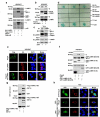LAMR1 restricts Zika virus infection by attenuating the envelope protein ubiquitination
- PMID: 34282707
- PMCID: PMC8293954
- DOI: 10.1080/21505594.2021.1948261
LAMR1 restricts Zika virus infection by attenuating the envelope protein ubiquitination
Abstract
Zika virus (ZIKV) infection can cause severe neurological disorders, including Guillain-Barre syndrome and meningoencephalitis in adults and microcephaly in fetuses. Here, we reveal that laminin receptor 1 (LAMR1) is a novel host resistance factor against ZIKV infection. Mechanistically, we found that LAMR1 binds to ZIKV envelope (E) protein via its intracellular region and attenuates E protein ubiquitination through recruiting the deubiquitinase eukaryotic translation initiation factor 3 subunit 5 (EIF3S5). We further found that the conserved G282 residue of E protein is essential for its interaction with LAMR1. Moreover, a G282A substitution abolished the binding of E protein to LAMR1 and inhibited LAMR1-mediated E protein deubiquitination. Together, our results indicated that LAMR1 represses ZIKV infection through binding to E protein and attenuating its ubiquitination.
Keywords: E protein; Laminin receptor 1, LAMR1; Zika virus, ZIKV; eukaryotic translation initiation factor 3 subunit 5, EIF3S5; ubiquitination.
Conflict of interest statement
No potential conflict of interest was reported by the authors.
Figures





Similar articles
-
USP38 Inhibits Zika Virus Infection by Removing Envelope Protein Ubiquitination.Viruses. 2021 Oct 8;13(10):2029. doi: 10.3390/v13102029. Viruses. 2021. PMID: 34696459 Free PMC article.
-
Zika Virus Encoding Nonglycosylated Envelope Protein Is Attenuated and Defective in Neuroinvasion.J Virol. 2017 Nov 14;91(23):e01348-17. doi: 10.1128/JVI.01348-17. Print 2017 Dec 1. J Virol. 2017. PMID: 28931684 Free PMC article.
-
Envelope protein ubiquitination drives entry and pathogenesis of Zika virus.Nature. 2020 Sep;585(7825):414-419. doi: 10.1038/s41586-020-2457-8. Epub 2020 Jul 8. Nature. 2020. PMID: 32641828 Free PMC article.
-
Zika Virus Envelope Protein and Antibody Complexes.Subcell Biochem. 2018;88:147-168. doi: 10.1007/978-981-10-8456-0_7. Subcell Biochem. 2018. PMID: 29900496 Review.
-
Structures of Zika Virus E & NS1: Relations with Virus Infection and Host Immune Responses.Adv Exp Med Biol. 2018;1062:77-87. doi: 10.1007/978-981-10-8727-1_6. Adv Exp Med Biol. 2018. PMID: 29845526 Review.
Cited by
-
Ubiquitination of NS1 Confers Differential Adaptation of Zika Virus in Mammalian Hosts and Mosquito Vectors.Adv Sci (Weinh). 2024 Oct;11(39):e2408024. doi: 10.1002/advs.202408024. Epub 2024 Aug 19. Adv Sci (Weinh). 2024. PMID: 39159062 Free PMC article.
-
The Evolving Role of Zika Virus Envelope Protein in Viral Entry and Pathogenesis.Viruses. 2025 Jun 6;17(6):817. doi: 10.3390/v17060817. Viruses. 2025. PMID: 40573410 Free PMC article. Review.
-
ZDHHC11 Suppresses Zika Virus Infections by Palmitoylating the Envelope Protein.Viruses. 2023 Jan 2;15(1):144. doi: 10.3390/v15010144. Viruses. 2023. PMID: 36680184 Free PMC article.
-
The dual role of ribosomal protein SA in pathogen infection: the key role of structure and localization.Mol Biol Rep. 2024 Sep 4;51(1):952. doi: 10.1007/s11033-024-09883-x. Mol Biol Rep. 2024. PMID: 39230600 Review.
-
Deubiquitination complex platform: A plausible mechanism for regulating the substrate specificity of deubiquitinating enzymes.Acta Pharm Sin B. 2023 Jul;13(7):2955-2962. doi: 10.1016/j.apsb.2023.02.019. Epub 2023 Mar 4. Acta Pharm Sin B. 2023. PMID: 37521861 Free PMC article. Review.
References
-
- Dick GW, Kitchen SF, HADDOW AJ, et al. Isolations and serological specificity. Trans R Soc Trop Med Hyg. 1952;46(5):509–520. - PubMed
-
- Duffy MR, Chen TH, Hancock WT, et al. Zika virus outbreak on yap island, federated states of micronesia. N Engl J Med. 2009;360(24):2536–2543. - PubMed
-
- Pierson TC, Diamond MS. The emergence of Zika virus and its new clinical syndromes. Nature. 2018;560(7720):573–581. - PubMed
Publication types
MeSH terms
Substances
LinkOut - more resources
Full Text Sources
Medical
Molecular Biology Databases
Miscellaneous
